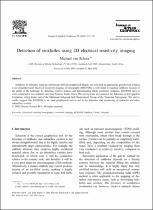JavaScript is disabled for your browser. Some features of this site may not work without it.
- ResearchSpace
- →
- Research Publications/Outputs
- →
- Journal Articles
- →
- View Item
| dc.contributor.author |
Van Schoor, Michael

|
en_US |
| dc.date.accessioned | 2007-02-06T08:37:19Z | en_US |
| dc.date.accessioned | 2007-06-07T10:02:43Z | |
| dc.date.available | 2007-02-06T08:37:19Z | en_US |
| dc.date.available | 2007-06-07T10:02:43Z | |
| dc.date.copyright | en_US | |
| dc.date.issued | 2002-07 | en_US |
| dc.identifier.citation | Van Schoor, M. 2002. Detection of sinkholes using 2D electrical resistivity imaging. Journal of applied geophysics, vol 50(4), pp 393-399 | en_US |
| dc.identifier.issn | 0926-9851 | en_US |
| dc.identifier.uri | http://hdl.handle.net/10204/1474 | en_US |
| dc.identifier.uri | http://hdl.handle.net/10204/1474 | |
| dc.description.abstract | Sinkholes in dolomitic areas are notoriously difficult geophysical targets, and selecting an appropriate geophysical solution is not straightforward. Electrical resistivity imaging or tomography (RESTOM) is well suited to mapping sinkholes because of the ability of the technique for detecting resistive features and discriminating subtle resistivity variations. RESTOM surveys were conducted at two sinkhole sites near Pretoria, South Africa. The survey areas are located in the dolomites of the Lyttelton Formation, which forms part of the Malamani Subgroup and Chuniespoort Group of the Transvaal Super group. The survey results suggest that RESTOM is an ideal geophysical tool to aid in the detection and monitoring of sinkholes and other subsurface cavities. | en_US |
| dc.format.extent | 327791 bytes | en_US |
| dc.format.mimetype | application/pdf | en_US |
| dc.language.iso | en | en_US |
| dc.publisher | Elsevier Science BV | en_US |
| dc.rights | Copyright: 2002 Elsevier Science Ltd | en_US |
| dc.source | en_US | |
| dc.subject | Cavities | en_US |
| dc.subject | Dolomite | en_US |
| dc.subject | Sinkholes | en_US |
| dc.subject | RESTOM | en_US |
| dc.subject | Geoelectric imaging | en_US |
| dc.subject | Resistivity tomographies | en_US |
| dc.title | Detection of sinkholes using 2D electrical resistivity imaging | en_US |
| dc.type | Article | en_US |
| dc.identifier.apacitation | Van Schoor, A. M. (2002). Detection of sinkholes using 2D electrical resistivity imaging. http://hdl.handle.net/10204/1474 | en_ZA |
| dc.identifier.chicagocitation | Van Schoor, Abraham M "Detection of sinkholes using 2D electrical resistivity imaging." (2002) http://hdl.handle.net/10204/1474 | en_ZA |
| dc.identifier.vancouvercitation | Van Schoor AM. Detection of sinkholes using 2D electrical resistivity imaging. 2002; http://hdl.handle.net/10204/1474. | en_ZA |
| dc.identifier.ris | TY - Article AU - Van Schoor, Abraham M AB - Sinkholes in dolomitic areas are notoriously difficult geophysical targets, and selecting an appropriate geophysical solution is not straightforward. Electrical resistivity imaging or tomography (RESTOM) is well suited to mapping sinkholes because of the ability of the technique for detecting resistive features and discriminating subtle resistivity variations. RESTOM surveys were conducted at two sinkhole sites near Pretoria, South Africa. The survey areas are located in the dolomites of the Lyttelton Formation, which forms part of the Malamani Subgroup and Chuniespoort Group of the Transvaal Super group. The survey results suggest that RESTOM is an ideal geophysical tool to aid in the detection and monitoring of sinkholes and other subsurface cavities. DA - 2002-07 DB - ResearchSpace DP - CSIR KW - Cavities KW - Dolomite KW - Sinkholes KW - RESTOM KW - Geoelectric imaging KW - Resistivity tomographies LK - https://researchspace.csir.co.za PY - 2002 SM - 0926-9851 T1 - Detection of sinkholes using 2D electrical resistivity imaging TI - Detection of sinkholes using 2D electrical resistivity imaging UR - http://hdl.handle.net/10204/1474 ER - | en_ZA |






